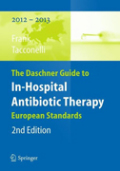
The Daschner guide to in-hospital antibiotic therapy: European standards
Frank, Uwe
Tacconelli, Evelina
Handy – concise – clear. The “always on-hand” pocket guide to the treatment of infectious diseases. - The most important antibiotics and antimycotics:. Spectrum – dosage – side-effects. - Numerous tables sorted by substances, pathogens, indications. - Administration of antibiotics during pregnancy, renal and hepatic insufficiency, dialysis. - Including statements on the cost of therapy.Numerous tips and troubleshooting guides on topics such as:. - Potential mistakes. - Therapy failures. - Perioperative antibiotic prophylaxis. Adjusted to European standards:. Up-to-date substances, authorizations, resistances and trade names. The first guide to antibiotic therapy for Europe!. All in all, an approach that looks towards the future in which antimicrobial resistance will certainly represent an ever-growing obstacle for the medical class, and for which books like this will undoubtedly represent a precious resource. Giuseppe Cornaglia, MD, PhD. President, European Society of Clinical Microbiology and Infectious Diseases (ESCMID). This book will most certainly be a valuable asset for all those treating patients with infections. While primarily aimed at the hospital setting, most of the very useful information can certainly be used in other healthcare settings, too. Andreas Voss. Professor of Clinical Microbiology and Infection Control. Radboud University Nijmegen Medical Centre and Canisius-Wilhelmina Hospital. Nijmegen, The Netherlands. Handy - concise - clear. The 'always on-hand' pocket guide to the treatment of infectuous diseases. The most important antibiotics and antimycotics: Spectrum - dosage - side-effects. Numerous tables sorted by substances, pathogens, indications. Administration of antibiotics during pregnancy, renal and hepatic insufficiency, dialysis. Including statements on the cost of therapy. INDICE: 1 Classification of the Antibiotics. 2 Generic and Trade Names – Trade Names and Generics. 3 Principles of Antibiotic Therapy. 4 The Most CommonErrors in Antibiotic Therapy. 5 Important Infections and Their Microbiological Diagnosis. 6 Cooperation with Microbiologists. 7 Resistance of Major Clinical Pathogens. 8 The Most Frequent Pathogens – Choice of Antibiotics. 9 Antibiotics, Antimycotics: Spectrum – Dosage – Adverse Effects – Costs. 10 Antibiotic Therapy of the Principal Infections in Children and Adults. 11 Treatment of the Most Frequent Types of Bacterial Endocarditis. 12 Minimal Duration of Treatment for Bacterial Infections. 13 Failure of Antibiotic Therapy. 14 Fever of Unknown Origin: Differential Diagnosis. 15 Dosage of Antibiotics in Impaired Renal Function. 16 Antibiotic Therapy in Hemodialysis, Peritoneal Dialysis, and Continuous Hemofiltration. 17 Antibiotic Therapy During Pregnancy and Lactation. 18 Antibiotics in Liver Diseases. 19 Diffusion of Antibiotics in Cerebrospinal Fluid and in Cerebral Abscesses. 20 Local Antibiotics. 21 Prophylactic Antibiotic Therapy. 22 Physical Incompatibility of Antibiotics and Antimycotics inInfusion Solutions. 23 Useful Websites. Subject Index.
- ISBN: 978-3-642-18401-7
- Editorial: Springer Berlin Heidelberg
- Encuadernacion: Rústica
- Páginas: 300
- Fecha Publicación: 20/07/2011
- Nº Volúmenes: 1
- Idioma: Inglés
